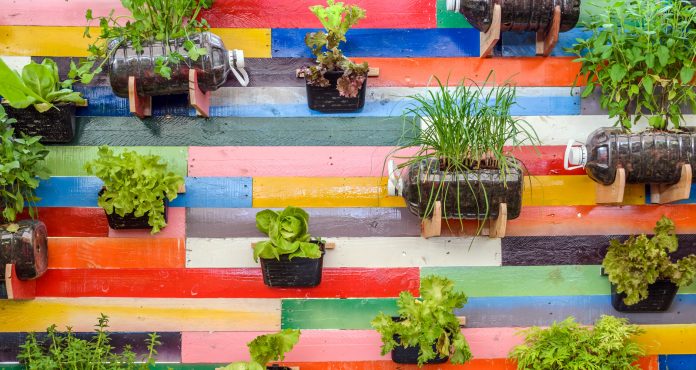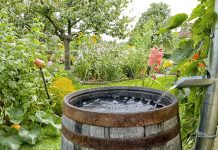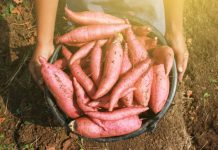Nothing to see here, just lots of gardening tips, tricks, secrets, and hacks!
1. Honey for rooting slips
Instead of buying hormone rooting powder use honey – when you cut your slip for planting, smear some honey on it. It will significantly increase the success rate of slips and give them a measure of protection from soil borne attacks. Just remember to keep all slips moist to encourage roots to form.
2. Never buy seed trays again
Save supermarket fruit and vegetable containers- the clear plastic is useful for starting seeds or small cuttings like thyme or rosemary before planting them out.
3. Sowing seeds with a rake
To get even spacing to use a metal garden rake – push wine corks onto the ends of the tines and use this to make holes in the ground for your seeds. Alternatively, take a scrap piece of wood, a wooden dowel cut into 3-inch (7cm) lengths – drill holes into the wood the size of the dowel stick so it fits snugly at even intervals then glue dowel sticks into place.
Press this into the ground for even spacing – the harder you press the deeper the seed hole.
4. Never buy lavender plants again
Before you lavender bushes start dying off-take lots of cuttings, smear with honey and root in small pots or a large tray to get new plants started to replace the bushes as they die off.
5. Egg cartons for starting seeds
Put the soil into each cardboard carton cup and plant one seed per cup. Stand on a tray and keep moist from the top. When you are ready to plant, cut the compartments apart and plant them complete in the ground. There will be no transplant shock for the seedlings and the cardboard will soon dissolve and enrich the soil.
Related: Storage-Friendly Survival Gardening
6. Soak vegetable seed before planting
Make up a mild seaweed fertilizer solution and soak vegetable seed in it for a couple of hours while you prepare the beds for planting. It helps produce vigorous seedlings.
7. Crush cilantro seeds to encourage germination
Cilantro (coriander) seeds are hard little balls with a fibrous husk –crushing them underfoot helps before planting as often the seed battles to break through the hard husk – otherwise soak them for a day in water or the seaweed solution mentioned above.
8. Transplant on a cloudy day
Choose to transplant seedlings on a cloudy day – often the fierce midday sun can be too much for seedlings – this way they have at least have 24 hours to get established.
9. Propagating African Violets (saintpaulia)
Forget the tin foil over a glass and the leaf poking through – simply put your fresh cut leaves from your African violets into good loamy soil in pots. Use a stick to poke a hole in the soil and then gently firm the soil around the leaf.
Stand the pots in a drip tray and make sure the drip tray is never without water – the soil will draw the moisture up. Just make sure the leaves are planted upright and do not touch the sides of the pot. Keep in a warm place that does not have direct sunlight but plenty of light and in a couple of months, you’ll have new baby plants. Do not use honey or any rooting powder – the leaf needs is to be handled as little as possible. Never ever, water the leaves of the African violets unless you have a very fine misting system – water on the leaves spells crown rot.
10. Toilet paper seed tape
If you feel thinning out seedlings is wasteful to make your own seed tape – use a two-ply toilet paper, make a paste using a tablespoon of flour mixed with enough water to create a paste that’s of medium consistency. Dab it on at the spacing interval suggested on the seed packet – and place your seeds – any extras that fall on the spaces between the dots of paste won’t adhere and can be used on the next piece. Keep your toilet paper piece no more than 3 feet long so they are easy to work with. Allow to dry, roll up and plant later, or plant immediately.
Related: What is Hydroponic Gardening?
11. Cinnamon for seedlings
Shake ground cinnamon around seedlings to repel pests. It has anti-fungal properties.
12. Grow new plants from your purchased produce
Unless the plant has been genetically modified – and one shouldn’t be buying GM food anyway – the seeds when saved can be planted. Cut open chilies and save the seeds, the same with green peppers. Save a few fresh peas and beans to replant. Tomato gone squishy? Save the seeds and plant them. Buying the produce – which you can eat and get seeds from too, works out cheaper than buying packets of seed.
13. Allow plants to go to seed and reap the benefits
Let lettuce, cilantro, and other vegetables go to seed so that you can harvest the seed and plant again for the next year. The beauty with this is that the plants have got used to the environment and nutrients in the soil in which they are growing so the seeds will germinate more readily than seeds introduced from somewhere else.
14. Easily grow avocados from seed.
Don’t throw away the large seed from an avocado. Throw them down into a damp patch – they don’t need to be covered and as long as the soil is always moist they will soon be sprouting. Yes, they take 10 years to bear fruit but as the saying goes about planting trees the best time was 200 years ago and the second-best time is now.
15. Ginger
When you buy ginger root at the greengrocer, reserve three pieces and plant them in a large pot with a good potting mix. Once the ginger has grown well you can dig out a bit of root when you need it and leave the plants to continue growing, meaning you probably won’t be needing to go to the greengrocer for ginger again.
Related: Top 13 Prepping And Survival Items You Can Find At Farm Auctions
16. One pineapple equals one plant
When you have fresh pineapples to eat cut the top off with sufficient flesh attached and plant in sandy soil that is kept moist – the tops will grow and produce plants that will give you plenty of pineapples.
17 Passion fruit vines from seed
Save and plant the seed from fresh passion fruit. Ensure it is kept moist and soon vines will be growing – transplant carefully to a spot where they can ramble up a tree or have a trellis that has sufficient support. Soon you’ll have your own passion fruit to add to desserts.
Water
18. DIY watering can


You don’t need to buy a watering can. Repurpose a plastic milk container that comes with a handle. Poke holes with a large hot needle in the plastic lid. Voila – a watering can. Place one at each tap point in the garden so you don’t have to walk around looking for a watering can. If you want to control the spray then place the cone part cut from of a plastic soda bottle over the neck before screwing on the lid – then you have more control when watering patio and houseplants.
19. Automatically water plants
Keep those used plastic water bottles out of the landfill and in your garden. Dig a hole and plant a water bottle that has been poked with holes on the sides and bottom next to a plant – fill with water so it can slowly release water to the plant through the holes.
20. Create a vertical wall of plants from plastic bottles
Watch this video to see how a school is transformed in Israel:
You can do it on a smaller scale by cutting out a piece in the side of plastic beverage bottles, fitting the top of one with the lid on it through the base of the one below it so it sits snugly. The topmost row is filled with bottles that contain water dripping slowly from the hole in the cap permeate down from the top row to the rows below as each cap has a hole in it.
Related: 4 Useful Harvesting Tips
21. Rag and wine water dispenser
Put a wine jar filled with water upright next to a pot plant and place a wet rag in it leading to the plant – the moisture will slowly transfer to the plant as long as the plant is at a slightly lower level than the top of the wine bottle.
22. Automatic plant water dispenser
Place a wine jar filled with water upside down in a pot plant. Make sure it is pushed firmly into the soil so it can slowly release the water while you are away.
23. Self-watering wall system
Cut off the bottoms of plastic bottles and retain the rest including the screw-top cap into which you have made a hole. Place into a set of PVC fittings as shown in this video:
…with a full bottle in the PVC pipe on the side to ensure the seedlings keep getting water.
24. Watering at the root level
When you need to get water to the roots then follow this method.
Squash, butternut, pumpkins – plant a large plastic pot in the ground with just an inch or so of the rim above ground. Prepare your hills for planting around the pot. When the seeds are established and needed plenty of water into the pot – the water will filter out slowly into the ground at root level feeding the plants – you can also add compost or a seaweed emulsion to the water to give the plants added nutrition.
25. Coffee filters to stop soil loss
Putting coffee filters in the bottom of a pot plant will stop the soil leaking out when you water and prevent clogging at the bottom of the pot.
Related: 18 Vintage Homesteading Tools to Search for at Garage Sales
Soil Health
26. Put earthworms to work
To improve the soil around trees, especially fruit trees, save all household scraps, grass clippings, and leaves. Spread around the tree at the edge of the canopy – not up against the trunk of the tree. Cover the layer with leaves or a small layer of soil. The worms will soon move in to eat the matter and the worm casts will increase the nitrogen, phosphate, potash, and humus in the soil, resulting in trees that are more vigorous and produce better crops.
27. Eggshells to improve soil
Crush your eggshells and dig into the garden – they are rich in calcium, which the plants need to grow strong.
28. Chicken tractors
Use a chicken tractor to fertilizer, remove weeds and keep the chickens happy. This video shows you how to build one:
You won’t need to weed as much, buy chicken manure, plus the chickens will provide you with eggs.
29. Conveyor belt type compost piles
Instead of having one compost heap and moving the compost to various areas of the garden have a number of small ones going in the various garden beds. Add the weeds you have pulled out –onto the heap – add cutting and leaves, kitchen refuse and allow to break down. You’ll see lots of activity from insects and earthworms will soon move in.
Once you think it is ready to move the dry stuff off the top and start the new heap next to it – moving your way across the beds. What is left behind will be fertile soil, ready for planting. No backbreaking wheeling loads of compost around and digging it in.
30. Tea leaves for soil balance
The leftovers in the tea bag make soil healthier by promoting bacterial processes. Once a tea bag has been in boiling water most of the acid is removed. Adding the contents of teabags – not the bag itself will leave your soil with a 6.5PH level that encourages vibrant growth. Purists prefer tea without that doesn’t come in a teabag, which makes saving the tea leaves even easier.
31. Cardboard and newspaper to retain moisture
This may take a while but it is the easiest way to start a garden in a new piece of ground where the soil is rock hard and lacks nutrients. Lay down all the cardboard you throw away like old packaging boxes, egg cartons, and so on, then top the cardboard layer with old newspaper, non-coated paper, envelopes – whatever paper would normally go in the trash. Cover with kitchen cuttings, cuttings from the garden and layers of leaves and. Water thoroughly. Top with some sand or soil.
Plant your seedlings into this mix with a handful of good loamy soil to start them and make sure to keep them watered in the beginning – all the materials will eventually break down creating healthy soil that retains moisture.
Dealing with weeds
32. Fill every inch of ground space
Try to avoid blank spaces in your garden – every inch of soil should be covered – it stops weeds developing and keeps moisture in the soil – for example, use strawberries as a ground cover. Plant plants that won’t compete for root space – deep-rooted, medium roots and shallow cover plants – this way the weeds can’t get a foothold.
33. Boiling water for weeds
To get rid of weeds between paving stones and other spots around the yard pour boiling water on the weed. Make sure it doesn’t get onto the plants you want to keep!
34. Vinegar to kill weeds between pavers
Get rids of weeds with vinegar and salt. Take ½ a gallon of vinegar and mix with ½ a cup of salt. Add a dessertspoon of dishwashing liquid – this makes the mixture stick to the leaves of the weeds. Spray on a warm sunny day when the leaves will absorb the mix. Remember salt kills all plants and is no good for the soil so ONLY use between pavers or where pavers abut the walls of the house.
35. Straw or leaves to control weeds
Spread straw or raked up leaves on the ground between plants to discourage weeds. The layer will also provide a haven for insects and lizards that prey on other garden pests.
Deterring Pests
36. Luring birds away from your fruit
Instead of the birds eating your pears or plums try to lure them elsewhere by planting mulberries and other berries which they prefer – leaving the majority of your fruit alone. Unfortunately in the case of cherries and apples particularly as they are some of the birds’ favorite fruit this won’t work and you may need to use nets to protect the trees or try one of the suggestions below.
37. CDs for the birds
Tie old CDs on nylon strings or shiny strips of tape to the trees that move in the wind. The light and movement scare away the birds.
38. Owls to scare birds
A realistic-looking owl, hawk or snake in a prominent position may help but it will have to be moved often otherwise they will soon realize it’s a fake.
39. Coffee grounds around plants
Coffee grounds keep away pests, so when you have filter coffee don’t throw the stuff away. Place it around plants to give them some pest protection.
40. Use companion planting to control insects
Plant basil and marigold with tomatoes, to control pests naturally. This is just one example. Besides controlling insects, certain plants help each other with nutrients.
Related: Protecting Your Garden Against Pests And Diseases
41. Eggshells for slugs
To discourage slugs and snails crush up your eggshells by hand – some people use the blender but that just means more cleaning– and scatter them around plants subject to slug and snail attack. They will avoid crawling over the eggshells, as the sharp edges will create minute cuts on their bodies causing them to dehydrate and die.
42. Plants to discourage mosquitoes


Lemongrass (cymbopogon citratus)– is a close relative of citronella and will deter mosquitoes. Plant in tubs on your patio area – you can use it in Asian recipes and dogs seem to like chewing it as a health aid – they won’t ruin it –they just chew one stalk or so.
Citronella grass (cymbopogon nardus or cymbopogon winteratus) is the source of citronella oil – not the citronella pelargonium marketed as a mosquito repellant. Use the real citronella grass for best effect.
The Bay tree, Beebalm and catnip are also reported to be useful is deterring mosquitoes. The plants listed above won’t deter every single annoying mosquito but will certainly help keep the pests at bay.
43. Plants to deter flies
Lavender, rosemary and mint – plant them around chicken coops and place in kitchens.
44. Killing fruit fly larvae
In orchards and around fruit trees make sure to pick up all fallen fruit before fruit fly larvae can develop. Dig into the ground. If you have the time and space boil the rotting fruit with water in a large container outdoors and when cool add to the base of the trees as a mulch.
Using fences
45. Hedges as edible screens
Why should a hedge simply serve as a screen? Make them useful by planting edible hedging plants like blackberries and raspberries, cherry plum or quince or a mixture.
46. Roses as a protective fence
In small spaces plant, fragrant standard roses alongside a wire fence interspersed with low growing roses. Besides being beautiful you can use the petals to decorate salads, crystalize for cake and dessert decoration, strew on pathways or add to potpourri. Being thorny they will also discourage animals and people from trampling on them.
47. Espalier fruit trees to create a living fence.
This video shows you how to espalier trees so they grow into a flat shape in small spaces providing you with fruit without taking up massive amounts of room:





















